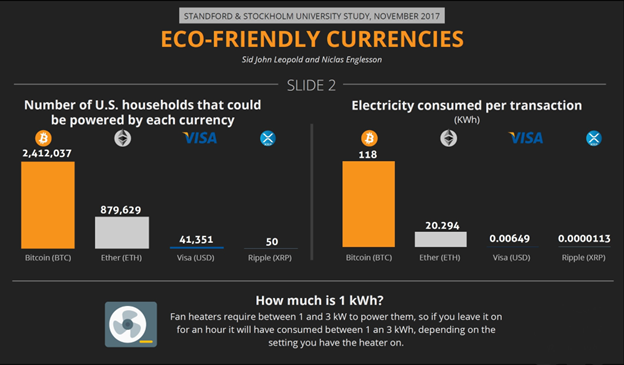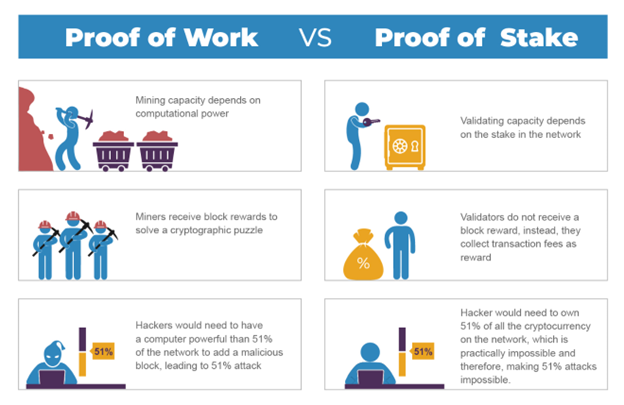Blockchain for Sustainable Business: Navigating a Greener and More Ethical Future
Blockchain technology, often lauded for its transformative potential, has faced its share of environmental concerns, largely attributed to the energy-intensive proof-of-work (PoW) consensus mechanism popularized by Bitcoin.

source
However, a paradigm shift is underway, with the rise of energy-efficient proof-of-stake (PoS) chains. As the world grapples with the urgency of sustainable practices, the integration of blockchain and sustainability has become a focal point.
This article delves into the nuanced relationship between blockchains and sustainability, exploring how PoS chains, exemplified by Ethereum’s transition, are leading the way to a more environmentally friendly blockchain ecosystem.
The PoW Predicament
The allure of Bitcoin’s decentralized currency came with a significant trade-off: its PoW consensus mechanism consumes substantial energy.
Mining Bitcoin requires immense computational power, leading to concerns about its environmental footprint. Critics argue that the energy consumption of PoW chains undermines their potential benefits and clashes with the imperative to combat climate change.

source
The Promise of PoS Chains
In contrast, PoS chains offer a more sustainable alternative. Ethereum’s monumental shift from PoW to PoS highlights the viability of this approach.
PoS replaces energy-intensive mining with validators who are chosen to create new blocks based on the number of coins they hold and are willing to “stake” as collateral. This transition drastically reduces the energy consumed, positioning PoS as a key player in the pursuit of sustainable blockchain solutions.
Ethereum’s Green Metamorphosis
Ethereum, a trailblazer in blockchain innovation, recently executed its long-anticipated upgrade to Ethereum 2.0, transitioning from PoW to PoS. This monumental shift resulted in a staggering 99.9% reduction in energy consumption. The network’s carbon footprint is now akin to that of a small town, a far cry from the power-hungry image associated with PoW chains.
Navigating Challenges
While the transition to PoS offers a greener path, challenges remain. Critics highlight potential vulnerabilities in PoS, such as the “nothing at stake” problem, where validators could hypothetically support multiple conflicting chains. Furthermore, equitable distribution of coins among stakeholders to maintain decentralization requires careful calibration.
Heading Towards a Greener Future
The evolution from PoW to PoS marks a significant step toward reconciling blockchain technology with environmental concerns. As more projects explore PoS and other energy-efficient consensus mechanisms, the narrative around blockchain’s impact on sustainability is shifting.
Blockchain, rather than being an obstacle, could emerge as a catalyst for sustainable development.
Using Blockchain to Foster Business Sustainability
In an era marked by increasing environmental awareness and corporate social responsibility, businesses are actively seeking innovative solutions to align their operations with sustainable practices.
Blockchain technology, renowned for its transparency, security, and traceability, offers a potent avenue to achieve this goal. Here’s a comprehensive guide on how to utilize blockchain to make your business more sustainable:
1. Supply Chain Transparency
Blockchain’s decentralized ledger system provides an unalterable record of transactions, making it an ideal tool for enhancing supply chain transparency.
By implementing blockchain, businesses can trace the journey of raw materials from their source to the final product. This ensures that ethical sourcing practices are adhered to, reducing the risk of using materials obtained through environmentally harmful or unethical means.
2. Ethical Sourcing and Fair Trade
Blockchain empowers consumers to verify the authenticity of ethical sourcing claims.
By recording each step of a product’s production on the blockchain, businesses can provide indisputable evidence of fair labor practices, sustainable sourcing, and adherence to fair trade principles. This not only builds consumer trust but also fosters a market demand for responsibly produced goods.
3. Carbon Footprint Tracking
Blockchain’s real-time tracking capabilities can revolutionize the management of carbon emissions.
Businesses can accurately measure their carbon footprint throughout the supply chain, from manufacturing to distribution. This data can then be used to identify areas for improvement, optimize processes, and make informed decisions to reduce environmental impact.
4. Renewable Energy Integration
Integrating blockchain with renewable energy sources can streamline energy distribution and trading.
Blockchain-based platforms can facilitate peer-to-peer energy trading, allowing businesses to sell excess renewable energy to other entities within the network. This encourages the use of sustainable energy sources and contributes to a greener energy ecosystem.
5. Waste Management and Recycling
Blockchain can revolutionize waste management by tracking the disposal and recycling of materials. This ensures that waste is properly managed, reduces illegal dumping, and encourages recycling efforts.
Additionally, blockchain can incentivize individuals and businesses to participate in recycling programs through token rewards or other mechanisms.
6. Smart Contracts for Sustainability Agreements
Smart contracts, self-executing contracts with predefined conditions, can automate sustainability agreements.
These contracts can ensure compliance with ethical and sustainable practices, such as carbon offset commitments, resource-efficient production processes, and responsible waste management. Automated enforcement minimizes the risk of human error and ensures consistent adherence.
7. Stakeholder Engagement and Accountability
Blockchain’s transparency fosters accountability and stakeholder engagement. Businesses can provide real-time data on their sustainability initiatives, allowing stakeholders to monitor progress and verify claims. This transparency builds trust and encourages active participation in sustainable initiatives.
8. Circular Economy Implementation
Blockchain can support the transition to a circular economy by enabling the tracking of product lifecycle stages. This includes the sourcing of materials, manufacturing, distribution, use, and end-of-life processes. The data collected can inform strategies to extend product lifecycles, reduce waste, and promote recycling and repurposing.
9. Impact Measurement and Reporting
Blockchain facilitates accurate impact measurement and reporting. Businesses can transparently record and verify sustainability metrics, such as carbon reduction, energy savings, and waste reduction. This reliable data can be shared with stakeholders, investors, and customers, showcasing the business’s commitment to sustainability.
Conclusion
The convergence of blockchains and sustainability is no longer a mere possibility; it’s a growing reality. The transition from PoW to PoS signifies a turning point in how blockchain technology can coexist with our planet’s limited resources.
As the world strives for a more sustainable future, blockchain’s potential to drive positive change while minimizing environmental harm becomes increasingly evident. The journey towards a green blockchain revolution is well underway, ushering in an era where innovation and responsibility go hand in hand.


















